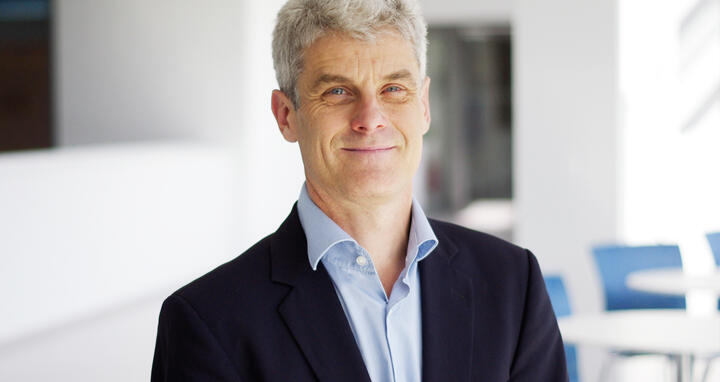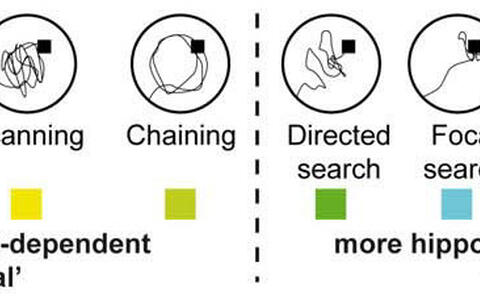Gerd Kempermann and the self-renewing brain
Adults are fascinated by children’s urge for movement and discovery and their drive to experience and learn new things all the time. Something worth keeping while growing up: it seems that an active life rich in experiences not only makes a better life but also keeps us mentally alert for longer. It turns out that a stimulating environment and physical activity influence the dividing activity of stem cells in the hippocampus region of the brain. In his basic research, Gerd Kempermann is exploring the mechanisms behind this relationship.
In his lecture at the Max Delbrück Center for Molecular Medicine (MDC) on January 22, Kempermann showed a traditional depiction of a person’s “stages of life”, resembling a staircase. “I am now up here on the top stair – so things are about to go downhill,” laughs Kempermann. But the descent does not need to be that steep: “We think that there is a neurogenic reserve that can be activated when needed,” he says. This “reserve tank” of nerve cells could enable successful and cognitively stable aging and help manage the effects of dementia. Kempermann shows a list of risk factors for Alzheimer’s. Sedentary and passive lifestyle is right at the top of the list. There is more truth to “Sitting kills!” than we like to think, says Kempermann. Mindful of the irony of saying this in a room full of seated people, he goes so far as to call this insight “one of the best-kept secrets in medicine.”
Kempermann is a medical doctor himself since 1995. He encountered his current research topic in the same year, when he worked as a postdoc at the renowned Salk Institute in San Diego. After three years he returned to Germany, where he combined his medical practice with research at Universität Regensburg’s Department of Neurology. In 2000 he became a full-time researcher, heading a group at the MDC. After seven productive years, he moved to Dresden to help set up the Center for Regenerative Therapies (CRTD), a DFG research center at TU Dresden. Today he is also spokesman for the Dresden site of the German Center for Neurodegenerative Disease (DZNE) within the Helmholtz Association.
The purpose of neuron growth in the adult brain
A couple of decades ago, the idea that adult brain cells might regenerate was still unthinkable. But this “adult neurogenesis” does in fact occur, but in a very limited amount. It turns out, the olfactory bulb and the hippocampus maintain a lifelong reserve of new nerve cells. This insight led to a paradigm shift in the last 20 years. The neurogenesis of hippocampus plays an important role in learning and forgetting. This part of the brain – named after the Greek word for seahorse for its shape – links learned knowledge with new information, and neurogenesis permits flexible learning. Kempermann illustrates this with an example: “You park your car in a different spot every day. This means that every day you have to update the virtual map in your mind. You don’t need to forget yesterday’s parking spot – you only need to integrate the new information into the old context.”
The hippocampus is affected early on in many neurodegenerative disorders, including dementia. That’s why people with Alzheimer’s find it difficult to cope with changes in their environment. The formation of new nerve cells in the hippocampus declines steadily with age, which means that the network of nerve cells loses flexibility. Learning becomes more difficult and we become more forgetful.
A stimulating environment causes hippocampus neurons to sprout in mice.
One of the ways in which Kempermann is testing his hypotheses about learning ability is by using mice and a small swimming pool: The Morris water maze. The maze contains white-colored water in which the swimming mice need to find a platform to rest. The platform is hidden just below the surface (video). After daily training, the animals soon learn to remember where the platform is and they head straight for it. The platform is then moved to a new position. Now it is interesting to see the differences in how the animals deal with the changed situation.
In his talk, Kempermann presents the findings of two recent studies. He tested mice that lived in a large “enriched” cage that was fitted out with toys and tunnels and where the mice could socially interact with other mice. The mice from the stimulating environment quickly remembered the new position of the platform in the water maze. Mice living in a standard cage without toys did less well: they spent longer searching for the resting place in the old position and had more trouble transferring their knowledge to the new situation. The search pattern of these mice indicates less involvement of the hippocampus.
Simply placing the standard cage inside the “enriched” cage did not rescue neurogenesis. The mice had to experience the stimulating environment directly to see activation of neurogenesis.
The effect is greatest in mice whose neurogenesis has been deliberately switched off, either genetically or by drugs. These animals find it much harder to learn the new position and spend a long time looking for the platform in its old place – irrespective of whether or not they were previously exposed to a stimulating environment.
The findings support the idea that cognitive and physical activity can active the “neurogenic reserve” and counteract the loss of neurogenesis in the adult brain. Also cell-based models help researchers understand this complex system. Developing new in-vitro stem-cell models is another important area of work in Kempermann’s laboratory. The scientists are also researching the regulatory networks responsible for activating the neuronal stem cells using a systems biology approach.
The seven years at the MDC have paid off for Kempermann and his research. It was here that he and his team became the first scientists to characterize adult neurogenesis in the hippocampus in detail. The results they obtained have enabled Kempermann to apply for many faculty positions. He has cooperated with Prof. Helmut Kettenmann and Prof. Thomas Willnow, among others, and still keeps in touch with them. Kettenmann recalls: “I was able to persuade him to come here from Regensburg. We had some very nice publications together.” When Kempermann headed for the CRTD Dresden in 2007, he told Nature: “The opportunity to enter a pioneering situation, building a new institute, is one that you rarely get.” Now he comments: “We were able to realize most of our ideas. These projects are still running and will continue for at least another five or six years. This type of research takes a lot of stamina.”
Kempermann’s work is an example of research on model systems with a message for everybody’s own life. In a first step in translating their research to humans, the scientists tried a large version of the Morris water maze on sports students. Kempermann explains how humans in a lake describe the basically same search patterns as the rodents in the swimming pool: “It turns out that humans are excellent model organisms for mice”.
Garthe, A., Roeder, I., & Kempermann, G. (2016): „Mice in an enriched environment learn more flexibly because of adult hippocampal neurogenesis.“ Hippocampus 26(2), 261–271. doi:10.1002/hipo.22520
Iggena, D., Klein, C., Garthe, A., Winter, Y., Kempermann, G., & Steiner, B. (2015): „Only watching others making their experiences is insufficient to enhance adult neurogenesis and water maze performance in mice.“ Scientific Reports 5, 14141. doi:10.1038/srep14141









